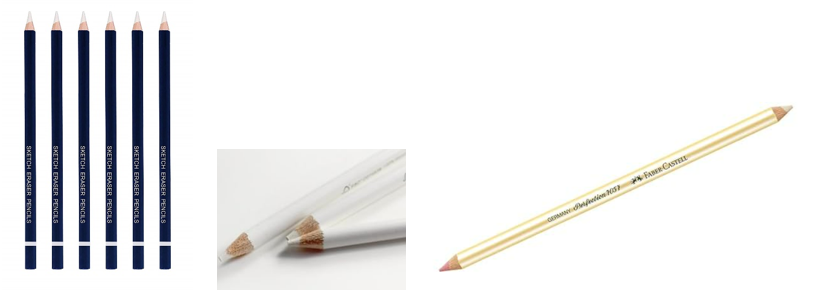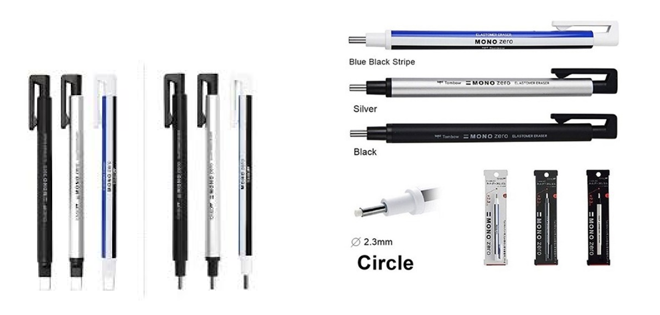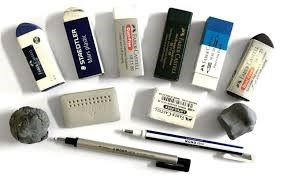ERASERS for ART & ARTISTS
- Kreative Minds
- Aug 28, 2024
- 5 min read
Write-up by AMRITA TIWARY

ERASER – an item of stationery that has been in our pencil boxes from the day we have learnt to write or scribble or sketch. It may be surprising for few to know that there are different kinds of erasers that are there in the market. Well, I am not just talking about the Electric erasers, pencil type erasers which are now a days quite famous with the school and college goers. Erasers for Artists – YES – An artist uses different types of erasers for their artworks.
Having different types of erasers in your drawing toolbox will be useful for producing realistic drawings
Before we get into the types of erasers, lets understand a little bit of the history of erasers.
History of Eraser:
Various types of erasers have been around in some form or another for quite some time. The rubber/eraser that are used today are very different from the early days one. In early days tablets of wax were used to remove the marks of charcoal or lead from the paper.
Pieces of crust-less bread were used as erasers in Japan during the years of 1868 to 1912.
In 1770, Edward Nairne, an English engineer, sold natural raw rubber erasers for the price of three shillings per half-inch cube.
In 1839, a man named Charles Goodyear used the process of vulcanization to cure the rubber and make it more durable (because raw rubber was perishable)
In 1858, Hymen Lipman received the first patent for attaching an eraser to the end of a pencil. Later, the patent was invalidated because it was determined to be a combination of two devices rather than a uniquely new product.
Types of Erasers:
When it comes to Art, not all erasers are created equal. In the supply list one may often see something called a “Pink Pearl” or Kneaded Eraser”. These and the other types of erasers are made from different materials and have their own unique purposes in the artwork of every artist. Here are the different types of erasers used by the artists.
Rubber Eraser
Gum Eraser
Kneaded Eraser
Vinyl Eraser
Pencil Eraser
Fiberglass Eraser
Elastomer Eraser
Sand Eraser

Rubber Eraser: These are pink erasers found on the end of every #2 pencils. In the art world you may recognize the name “PINK PEARL” which in a pink rubber eraser in the wedge shape. This eraser removes the graphite pencil marks on the papers by shedding itself as it lifts the marks. If used over-aggressively, it may tear the paper. The light-handed use is always recommended for this eraser.

Gum Eraser: also known as Art Gum Eraser have a completely different feel than that of a Pink Pearl. While these are also made of rubber, they are much softer than what we consider a typical rubber eraser. They are softer and have a gummy texture. When used, the Gum eraser starts to crumble - that is supposed to happen – the crumbs actually absorb the graphite. The best thing about the Gum eraser is that since they crumble, they do not tear up the paper. However, they do not tend to last as long as the other rubber erasers. (crumbling is the reason). These are mostly brown or beige in colour or sometimes even semi-transparent.

Kneaded Eraser: (also known as putty rubbers). We end up playing with this one more than we actually use it. That’s because, its soft, flexible, and can easily be formed and sculped into various shapes. It is easy to break into small pieces and work with it for smaller details by giving it the shape or points for the place where erasing is required. Kneaded erasers work by lifting the pigments of graphite & charcoal, off the surface leaving the paper absolutely undamaged with no smears. The flexibility of this eraser is popular amongst artists because it can be formed to a point for detailed areas – or whatever other shapes is required. To clean, simply stretch the eraser and fold over on itself (just kneading dough), create highlights or texture. They are not ideal for erasing large areas. If one is working with charcoal, a kneaded eraser is a must.

Vinyl Eraser: These are also called plastic erasers, are the toughest erasers on this list. If not used carefully, they can easily tear through the paper. These erasers are definitely handy as they can erase almost anything, even ink! Vinyl erasers are preferred by the draftsmen because of their clean and complete erasing. This often come in white and can be found in a variety of shops.

Pencil Eraser: Or Erasils – are made out of vinyl (as mentioned above) and come in pencil form. They can be sharpened to a point with a regular pencil sharpener, the same way as you would an ordinary pencil, making them ideal for small details, such as highlights in hair, fur, indentations etc. its always a good idea to wipe the tip of the eraser while working so you don’t smear graphite back to the work. Not to forget when these are made of vinyl, they can be very tough and can damage the paper of not used carefully.

Fiberglass Eraser: These erasers are made from spun glass and can be used for a variety of erasing applications. They come in difference grades, such as coarse and fine. It can be used for erasing printing marks, Indian ink from transparent papers, and on other inks that haven’t absorbed into the paper. Ecobra Fiberglass Eraser is common in the art world for erasing on parchment & transparent papers.

Elastomer Erasers: These are made from thermoplastic elastomers (TPEs), which are a combination of rubber and thermoplastic materials. TPEs are soft, malleable, and resistant to weather and chemical, making them ideal for erasers because they can be easily shaped and are durable. Elastomer erasers are often designed to be precise and protect artwork while erasing in details without damaging the paper/surface. They can be used for variety of purposes, including – Highlighting, lettering, journaling, calligraphy, detailed corrections & creating subtractive effects.

Sand Eraser: these are made from rubber and fine sand particles. The sand particles are abrasive and therefore cleanly removes the ink, pastel, colored pencils marks. These erasers don’t smudge, smear or leave any residue. However, because they are made from abrasive particles, should be avoid using on delicate papers.

Which Eraser is best for the Artist?
With so many options and different types of erasers available, it can be hard to know which one to choose. The type of eraser required will completely depend on the medium one is using and the type of paper/surface is working on. In general, kneaded erasers are the most versatile, while gum erasers are perfect for lightning large areas quickly. For ink or stubborn coloured pencil marks, one should opt for vinyl erasers.

The best erasers for graphite drawing: It is always suggested to go with a vinyl or plastic erasers, kneaded rubber erasers, and gum erasers.
The best erasers for charcoal drawing: Soft erasers, like kneaded erasers are best for lifting charcoal, this is to avoid smudging the loose particles. The charcoal will stick to the eraser and you can mold it to get into small areas.
The best erasers for pastel drawing: Kneaded rubber erasers are the best type of eraser to use for pastel because they don’t create as much dust. You can also use a gum eraser, but be careful not to press too hard or you might damage the paper.
Just a Tip: Make sure to clean erasers such as kneadable and vinyl erasers after using them with charcoal or pastel, as the dusty residue on the eraser could smudge onto the page. Clean a kneaded eraser by remolding it. A vinyl eraser can be cleaned by rubbing it on a clean, scrap sheet of paper to remove the residue.
Source of pictures: Google & internet
Source of information: Research from various papers & personal use of each eraser.
--------------------------------------x----------------------------------------
Comments